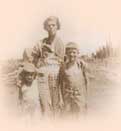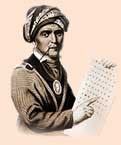KCAC National Theme Image Descriptions
 These
downtown Atlanta landmarks help to create the city's beautiful skyline. Pictured
clockwise from the top are 1) John Portman's Westin Peachtree Plaza Hotel,
the tallest hotel in the Western Hemisphere and home to the three-story revolving
Sun Dial Restaurant, 2) The former Winecoff Hotel, site of the famous 1946
fire that killed a record 119 people, spurring hotel fire safety measures
nationwide, and 3) The Carnegie Building, completed in 1925 as the Wynne-Claughton
Building and hailed during that year by the Atlanta Journal-Constitution for
its landmark exterior design, an excellent example of the late Commercial
style featuring curved corners that help the building fit into a difficult
triangular site.
These
downtown Atlanta landmarks help to create the city's beautiful skyline. Pictured
clockwise from the top are 1) John Portman's Westin Peachtree Plaza Hotel,
the tallest hotel in the Western Hemisphere and home to the three-story revolving
Sun Dial Restaurant, 2) The former Winecoff Hotel, site of the famous 1946
fire that killed a record 119 people, spurring hotel fire safety measures
nationwide, and 3) The Carnegie Building, completed in 1925 as the Wynne-Claughton
Building and hailed during that year by the Atlanta Journal-Constitution for
its landmark exterior design, an excellent example of the late Commercial
style featuring curved corners that help the building fit into a difficult
triangular site.
 Young
Jimmy Carter poses with his mother, Miss Lillian, and sister, Ruth, in rural
Plains, Georgia, circa 1933. The son of a farmer who owned land, he grew up
among the tenant sharecroppers, often working alongside them to harvest the
cash crops of peanuts and cotton for his family. From 1977 to 1981, the Georgia
native served as the thirty-ninth president of the United States. In addition
to his work as a University Distinguished Professor at Emory University after
his term, President Carter, along with his wife, Rosalynn, founded the Atlanta-based
Carter Center, a nonprofit organization
dedicated to advancing freedom and democracy throughout the world. The photo
appears in President Carter's autobiography, An Hour Before Daylight: Memories
of a Rural Boyhood. © Carter Family Collection, courtesy of Jimmy
Carter Library and Museum. Used by permission.
Young
Jimmy Carter poses with his mother, Miss Lillian, and sister, Ruth, in rural
Plains, Georgia, circa 1933. The son of a farmer who owned land, he grew up
among the tenant sharecroppers, often working alongside them to harvest the
cash crops of peanuts and cotton for his family. From 1977 to 1981, the Georgia
native served as the thirty-ninth president of the United States. In addition
to his work as a University Distinguished Professor at Emory University after
his term, President Carter, along with his wife, Rosalynn, founded the Atlanta-based
Carter Center, a nonprofit organization
dedicated to advancing freedom and democracy throughout the world. The photo
appears in President Carter's autobiography, An Hour Before Daylight: Memories
of a Rural Boyhood. © Carter Family Collection, courtesy of Jimmy
Carter Library and Museum. Used by permission.
 With
an exterior constructed of Indiana limestone and an interior boasting one-and-a-half
acres of Georgia marble, the Georgia
State Capitol Building was dedicated on July 4, 1889. It is the epitome
of Classic Renaissance style, as it features a prominent dome capped with
two applications of 23-karat gold. A statue of "Miss Freedom" tops
the structure, standing 15 feet tall and weighing 2000 pounds. The Capitol
building is the center of the State Capitol Complex, in which most of the
state government agencies are managed. On February 1, 2001, the Georgia
State Capitol Building became the first site to fly Georgia's new state
flag, which keeps, but reduces the size of, the controversial Confederate
battle emblem and places it alongside four state flags of Georgia.
With
an exterior constructed of Indiana limestone and an interior boasting one-and-a-half
acres of Georgia marble, the Georgia
State Capitol Building was dedicated on July 4, 1889. It is the epitome
of Classic Renaissance style, as it features a prominent dome capped with
two applications of 23-karat gold. A statue of "Miss Freedom" tops
the structure, standing 15 feet tall and weighing 2000 pounds. The Capitol
building is the center of the State Capitol Complex, in which most of the
state government agencies are managed. On February 1, 2001, the Georgia
State Capitol Building became the first site to fly Georgia's new state
flag, which keeps, but reduces the size of, the controversial Confederate
battle emblem and places it alongside four state flags of Georgia.
 Sequoyah,
born in 1776 near Tuskeegee, Tennessee, to the daughter of a Cherokee Chief
and a Virginia Fur Trader, developed the Cherokee writing system in 1809 after
moving to Georgia to flee the encroachment of the whites. Using a phonetic
system, he created "Talking Leaves," the 85 letters of the Cherokee
alphabet. In 1821, the Cherokee Nation officially adopted the system, which
helped lead to the publication of the first Native American newspaper, The
Cherokee Phoenix.
Sequoyah,
born in 1776 near Tuskeegee, Tennessee, to the daughter of a Cherokee Chief
and a Virginia Fur Trader, developed the Cherokee writing system in 1809 after
moving to Georgia to flee the encroachment of the whites. Using a phonetic
system, he created "Talking Leaves," the 85 letters of the Cherokee
alphabet. In 1821, the Cherokee Nation officially adopted the system, which
helped lead to the publication of the first Native American newspaper, The
Cherokee Phoenix.
 Two
Wheeler High School students share
the field and a friendly soccer competition in suburban Cobb County, Georgia.
Diversity is on the increase in the Cobb
County School District, which serves nearly 93,000 students.
Two
Wheeler High School students share
the field and a friendly soccer competition in suburban Cobb County, Georgia.
Diversity is on the increase in the Cobb
County School District, which serves nearly 93,000 students.